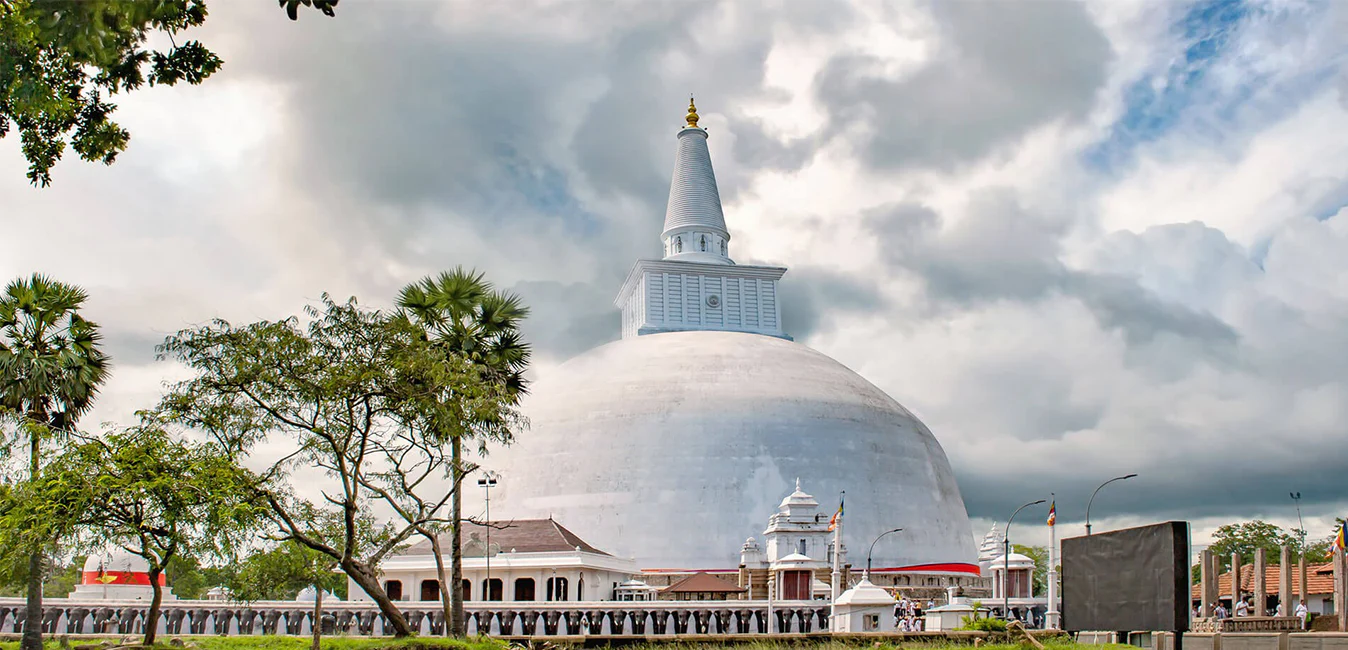
Anuradhapura City
Anuradhapura is belongs to the North Central Province in to Sri Lanka. Anuradhapura is one of the ancient capitals of Sri Lanka, famous for its well-preserved ruins of ancient Lankan civilization. The city, now a UNESCO World Heritage Site, lies 205 km north of the current capital Colombo in Sri Lanka.
Ruwanweliseya
Ruwanweliseya Stupa (Ruwanveli Seya Stupa), the foremost of the supremely glorious ancient living monuments of Sinhalese Buddhist Heritage at the city of Anuradhapura (a UNESCO World Heritage Site-Culture) was built by King Dutugamunu (161-137 BC), the Hero of the Nation, who hailed from Ruhuna, which was destined to give birth to most of the glorious heroes of the island nation of Sri Lanka from the ancient era to the modern day. Ruwanweliseya Stupa (Ruwanveli Seya Stupa) also called Maha Stupa (Sinhala: the great dagoba) or Ratnapali Stupa or Swarnamali stupa has been the most adored, most venerated among the great ancient stupas (dagobas) of Sri Lanka. Anuradhapura is replete with the ancient cultural monuments located in between the River Malwatu Oya and two great ancient man-made irrigation reservoirs called Tissa Wewa and Abhaya Wewa (Basawakkulama Wewa). These two ancient irrigation reservoirs, together with ancient Nuwara Wewa reservoir on the eastern flank of the River Malwatu Oya, extend the lifeline to the agricultural district of Anuradhapura.
The three main ancient stupas clustered south of the ruined Southern wall of Anuradhapura, namely Ruwanweliseya Stupa, Mirisavatiya Dagaba and Jetavana Stupa perfectly align with the celestial layout of Rigel, Mintaka and Bellatrix, three of the seven stars of the Orion constellation, which was associated with Osiris, the sun-god of rebirth and afterlife, by the ancient Egyptians (3150 BC-conventional Egyptian chronology).
And Anuradapura of Sri Lanka (SL Low gravity anomaly: -104m geoid), though far south of Bodh Gaya of Northern India, is only three and a half degrees west of it. Bodh Gaya, the location where Gauthama Buddha attained Supreme enlightenment, is considered Patavi Nahbi (Sanskrit: naval of the Earth), according to the Buddhist cosmology. Bodh Gaya’s antipode, on the other side of the world, that can be connected by an axis running through the very centre of the Earth, is the Temple of the Sun (referred to as the naval of the universe) of the Mayans (3114 BC Mesoamerican Long Count calendar) at the UNESCO World Heritage Site of Cuzco (Quechua, the Inca language: the navel of the universe) nearby Machu Picchu, the lost city of the Mayans.
Added to the inexplicable cosmological and geographical mysteries associated with Ruwanweliseya Stupa (Ruwanveli Seya Stupa), is the fact that locations for the construction of Ruwanweliseya and Mirisavatiya were determined by a couple of extraordinary circumstances. Still more astonishing is the sudden yet timely surfacing of precious metals and jewels at the beginning of the construction of Ruwanweliseya Stupa.
About Anuradhapura District
Anuradhapura is belongs to the North Central Province in to Sri Lanka. Anuradhapura is one of the ancient capitals of Sri Lanka, famous for its well-preserved ruins of ancient Lankan civilization. The city, now a UNESCO World Heritage Site, lies 205 km north of the current capital Colombo in Sri Lanka.
In the sacred city of Anuradhapura and in the vicinity are a large number of ruins. The ruins consist of three classes of buildings, dagobas, monastic buildings, and pokuna (ponds). The city had some of the most complex irrigation systems of the ancient world, situated in the dry zone of the country the administration built many tanks to irrigate the land. Most of the civilians are Sinhala, while Tamils and Sri Lankan Moors live in the district.
About North Central Province
North Central Province which is the largest province in the country covered 16% of total country's land area. North Central Province consist two districts called Polonnaruwa and Anuradhapure. Anuradhapura is the largest district in Sri Lanka. Its area is 7,128 km².
North Central Province has numerous potentials for Investors to start their Businesses, especially Agriculture, agro based industries and Livestock sectors. More than 65% of North Central Province's people depend on basic Agriculture and agro base industries. NCP also called "Wew Bendi Rajje" because there are more than 3,000 medium and large scale tanks situated in the province. Sri maha bodiya, Ruwanweli seya, Thuparama dageba, Abayagiri Monastry, Polonnaruwa Rankot wehera, Lankathilake are scared











